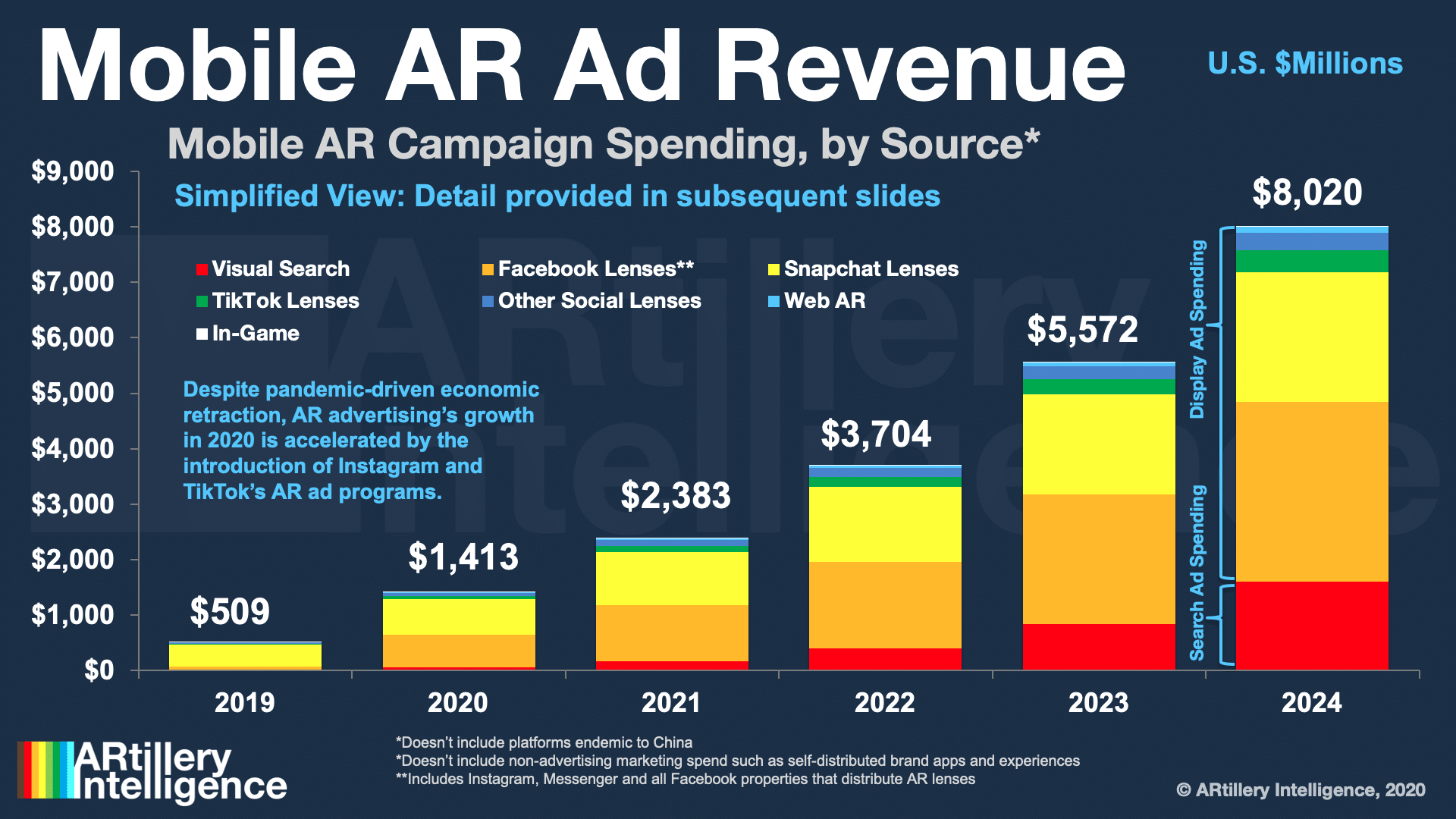
AR continues to evolve and take shape as an industry. Prominent sectors include industrial AR, social, gaming, and shopping. But existing alongside all of them is AR advertising. This includes paid/sponsored AR lenses that let consumers visualize products on “spaces & faces.”
Advertising is one of the most lucrative AR subsectors, on pace to reach $1.41 billion this year and $8.02 billion by 2024. These figures measure the money spent on sponsored AR experiences with paid distribution on networks like Facebook and Snapchat.
As our research arm ARtillery Intelligence examined in a recent report on AR advertising, adoption drivers include brand advertisers’ growing affinity for AR. Its ability to demonstrate products in 3D resonates with their creative sensibilities, transcending common 2D formats.
To continue the narrative and “show rather than tell,” part II of that report features case studies that map to various stages of the consumer purchase funnel. What do AR ads look like today, what’s the concrete ROI, and what are strategic takeaways for campaign execution?

Super-Sized
Starting our analysis at the top of the consumer-purchase funnel, what are best practices in using AR to amplify brand messaging or product awareness on a large scale? Who are the exemplars? What are the results they’re achieving? And how are they getting those results?
Picking up where we left off last week in looking at Purina’s AR ad campaign, we’ll move on to the next case study: the NFL. In fact, last week’s case study mentioned “Superbowl-sized” audiences, which relates in a literal sense to the NFL’s Superbowl LIII AR campaign.
Fans of both teams were offered “sticker packs” on Snapchat which included team-branded AR selfie filters to show their support. The result was a high degree of user engagement through captured selfies that were augmented and shared…as AR lenses usually go.
But more notable about this campaign was its reach. It was viewed 303 million times. As noted in the last week’s Purina case study, the Superbowl itself — often heralded as a benchmark for media reach and brand advertising — reaches just under 100 million TV viewers.

Depth of Engagement
Like the Purina campaign, there are quality and quantity benefits. Though it’s not specific to this campaign, Snapchat has reported that its AR active users engage 30-times per day on average. This far exceeds engagement levels in most other forms of ad media, except search.
Snapchat also reports that sponsored lenses average 10 to 15 seconds of playtime, 19 percentage-point lifts in ad awareness, 6-point lifts in brand awareness and 3.4-point lifts in action intent on average. They also achieve a 9-point lift in post-engagement product sales.
“There is a depth of engagement [on Snapchat],” NFL Digital Media VP Blake
Stuchin told Engaget. In fact, the NFL put its money where its mouth is, and has doubled down on Snapchat paid lens campaigns. It ran similar campaigns subsequent to the above.
Similar activations include the 2020 Superbowl (last February, right before COVID hit), where advertisers ran team-based AR lens campaigns. Snap reports that these lenses reached 45 million Snapchatter’s during Superbowl weekend for a total of 101 million impressions.
Acclimation & Education
The above campaigns come as AR faces doubt from brand advertisers about ROI and reach. AR can be a low reach play at times, but it’s telling that the Superbowl LIII campaign achieved 300 million+ engagements. Though an outlier, it could be a leading indicator of AR’s potential.
The advertiser disconnect cited above signals the need for education, as well as continued validation and experimentation from early-adopter brands like the NFL. Among the metrics outlined above, the key lesson for reach-driven brands is the scale that AR can achieve.
That realization and adoption by a larger share of brand advertisers will cycle in slowly, just as it did for mobile advertising. As noted earlier, this is happening to the tune of a projected $1.4 billion in AR ad revenue this year, on pace for $8.02 billion by 2024.
We’ll pause there and circle back in the next installment with another case study. Meanwhile, check out the full report here, and get more color in the video below.






